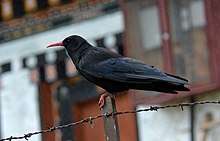Corvida
The "Corvida" were one of two "parvorders" contained within the suborder Passeri, as proposed in the Sibley-Ahlquist taxonomy, the other being Passerida. Standard taxonomic practice would place them at the rank of infraorder.
| Corvida | |
|---|---|
 | |
| Scientific classification | |
| Kingdom: | Animalia |
| Phylum: | Chordata |
| Class: | Aves |
| Order: | Passeriformes |
| Suborder: | Passeri |
| Parvorder: | Corvida |
| Families | |
|
See text | |
More recent research suggests that this is not a distinct clade—a group of closest relatives and nothing else—but an evolutionary grade instead. As such, it is abandoned in modern treatments, being replaced by a number of superfamilies that are considered rather basal among the Passeri.
It was presumed that cooperative breeding—present in many or most members of the Maluridae, Meliphagidae, Artamidae and Corvidae, among others—is a common apomorphy of this group.[1] But as evidenced by the updated phylogeny, this trait is rather the result of parallel evolution, perhaps because the early Passeri had to compete against many ecologically similar birds (see near passerine).
Placement of "Corvida" families
This table lists, in taxonomic order, the families placed in "Corvida" by the Sibley-Ahlquist taxonomy in the left column. The right column contains details of their placement in modern systematics.
Corvoidea and Meliphagoidea are placed basally among the Passeri too. They are, however, groups large enough to be considered superfamilies in their own right.
| Family | Modern placement |
|---|---|
| Menuridae: lyrebirds | Basalmost Passeri, close to Atrichornithidae |
| Atrichornithidae: scrub-birds | Basalmost Passeri, close to Menuridae |
| Climacteridae: Australian treecreepers | Basal Passeri, close to Ptilonorhynchidae |
| Ptilonorhynchidae: bowerbirds | Basal Passeri, close to Climacteridae |
| Maluridae: fairy-wrens, emu-wrens and grasswrens | Meliphagoidea. Nowadays several families. |
| Meliphagidae: honeyeaters and allies | Meliphagoidea |
| Pardalotidae: pardalotes, scrubwrens, thornbills, and gerygones | Meliphagoidea. Nowadays several families; Pardalotidae proper might belong in Meliphagidae |
| Petroicidae: Australasian robins | Passeri incertae sedis, close to Picathartidae |
| Orthonychidae: logrunners | Passeri incertae sedis, close to Pomatostomidae |
| Pomatostomidae: Australasian babblers | Passeri incertae sedis, close to Orthonychidae |
| Cinclosomatidae: whipbirds and allies | Corvoidea incertae sedis, relationships with Pachycephalidae unresolved |
| Neosittidae: sittellas | Corvoidea |
| Pachycephalidae: whistlers, shrike-thrushes, pitohuis and allies | Corvoidea incertae sedis, highly paraphyletic and relationships with Cinclosomatidae unresolved |
| Dicruridae: monarch flycatchers and allies | Corvoidea. Possibly paraphyletic |
| Campephagidae: cuckoo-shrikes and trillers (initially included in Laniidae) | Corvoidea |
| Oriolidae: orioles and figbirds | Corvoidea |
| Icteridae: American blackbirds/orioles, grackles and cowbirds | Passerida: Passeroidea (the most "modern" main lineage of songbirds) |
| Artamidae: woodswallows, butcherbirds, currawongs and Australian magpie | Corvoidea |
| Paradisaeidae: birds of paradise | Corvoidea |
| Cnemophilidae: satinbirds (included in Paradisaeidae) | Passeri incertae sedis, possibly close to Callaeidae |
| Corvidae: crows, ravens, jays, etc. | Corvoidea |
| Corcoracidae: white-winged chough and apostlebird | Corvoidea |
| Irenidae: fairy-bluebirds | Passeri incertae sedis; close to Passeroidea or Regulidae (kinglets) |
| Laniidae: shrikes | Corvoidea |
| Prionopidae: helmetshrikes (initially included in Laniidae) | Corvoidea |
| Malaconotidae: bush-shrikes and allies (initially included in Laniidae) | Corvoidea |
| Vireonidae: vireos | Corvoidea |
| Vangidae: vangas | Corvoidea |
| Turnagridae: piopios | Corvoidea (included in Oriolidae) |
| Callaeidae: New Zealand wattlebirds | Passeri incertae sedis, possibly close to Cnemophilidae |
In addition, the following families were not included in the "Corvida" although their closest relationships are with taxa included therein:
| Family | Sibley-Ahlquist placement | Modern placement |
|---|---|---|
| Platysteiridae: wattle-eyes | Passerida (included in Muscicapidae) | Corvoidea |
| Picathartidae: rockfowl | Passerida | Passeri incertae sedis, close to Petroicidae |
| Chaetopidae: rockjumpers | Passerida (Turdidae) | Passeri incertae sedis, close to Petroicidae |
| Melanocharitidae: berrypeckers and longbills | Passerida | Passeri incertae sedis, possibly close to Cnemophilidae |
| Paramythiidae: tit berrypecker and crested berrypecker | Passerida (included in Melanocharitidae) | Passeri incertae sedis, possibly close to Cnemophilidae |
Footnotes
- Cockburn (1996)
References
| Wikimedia Commons has media related to Corvida. |
| Wikispecies has information related to Corvida |
- Cockburn, A. (1996): Why do so many Australian birds cooperate? Social evolution in the Corvida. In: Floyd, R.; Sheppard, A. & de Barro, P. (eds.): Frontiers in Population Ecology: 21–42. CSIRO, Melbourne.